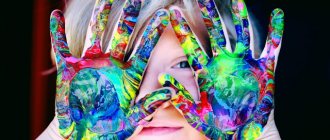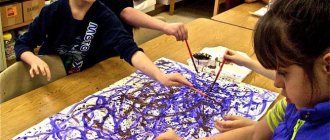Non-traditional appliqué techniques
Natasha Walter
Non-traditional appliqué techniques
Non-traditional appliqué techniques in kindergarten.
Every preschooler is a little explorer, discovering the world around him with joy and surprise. The child strives to be active, and it is important not to let this desire fade away and to promote his further development. The more complete and varied a child’s activity is, the more significant it is for the child and corresponds to his nature, the more successful his development is, the more potential opportunities and first creative manifestations are realized.
One of the closest and most natural types of activity for a preschool child is visual activity. Visual activity in kindergarten is an effective means of understanding reality. This activity helps the development and formation of visual perceptions, imagination, spatial concepts, memory, feelings and other mental processes. Such personality traits as perseverance, focus, accuracy, and hard work are formed.
In the process of visual activity, preschoolers acquire a whole range of graphic and pictorial skills and abilities, learn to analyze objects and phenomena of the surrounding world. This activity is important for the development of fine motor skills of the fingers, their muscles, and coordination of movements.
Applique translated from Latin means “attachment”
.
This is one of the types of fine art . It is based on cutting out various details and applying them to the background in a certain order. The parts are fixed to the base using various adhesives and threads.
Currently, a wide variety of elements can be used applique
Appliqué is one of the types of visual activity based on cutting out, overlaying various shapes and fixing them on another material, taken as the background; the simplest and most accessible way to create artistic works.
The application can be:
- subject, consisting of individual images (leaf, branch, tree, bird, flower, animal, person, etc.)
;
— plot, reflecting certain events;
- decorative, including ornaments and patterns that can be used to decorate various objects.
We, teachers, are inclined to the traditional technique of teaching children applications , namely:
1. Make a decorative pattern from various paper geometric shapes and plant (leaf, flower)
details, placing them in a certain rhythm on a cardboard base.
2. Make an image of an object from colored paper from separate parts; depict the plot.
3. Master various techniques for obtaining parts for appliqué from paper : cutting with different techniques, tearing, weaving; as well as the technique of attaching them to the base.
4. Compose an image of an object (plot)
using
the origami technique .
And it is rare to find teachers who use non-traditional appliqué techniques .
Today I want to introduce you to some appliqué techniques :
Working with various materials, in various artistic techniques expands the child’s capabilities, develops a sense of color, harmony, imaginative space, imaginative thinking, and creative abilities.
Types of non-traditional application
Broken applique .
This method is good for conveying the texture of an image (fluffy chicken, curly cloud)
.
In this case, we tear the paper into pieces and make an image from them. Children 5-7 years old can complicate the technique : not just tear pieces of paper as best they can, but pluck or tear off the outline drawing. Cutting appliqué is very useful for developing fine motor skills and creative thinking.
Overlay applique .
This technique allows you to obtain a multi-color image. We conceive an image and consistently create it, overlaying and gluing parts in layers so that each subsequent detail is smaller in size than the previous one.
Modular application (mosaic)
.
With this technique, an image is created by gluing many identical shapes. Cut out circles, squares, triangles, or simply torn pieces of paper can be used as the basis for a modular applique
Symmetrical applique .
For symmetrical images, fold the blank - a square or rectangle of paper of the required size - in half, hold it by the fold, and cut out half of the image.
Ribbon applique .
This method allows you to get not one or two, but many identical images, scattered or interconnected. To make a ribbon applique, you need to take a wide sheet of paper, fold it like an accordion and cut out the image.
Quilling
Quilling (English quilling - from the word quill (bird feather, also paper rolling) - the art of making flat or three-dimensional compositions from long and narrow strips of paper twisted into spirals.
Trimming
Trimming is one of the types of paper crafts. This technique can be attributed to both the applique method and the type of quilling . With the help of trimming you can create amazing three-dimensional paintings, mosaics, panels, decorative interior elements, postcards. This technique is quite popular , the interest in it is explained by the unusual “fluffy” effect and the easy way to perform it.
Collage
Collage (from the French collage - gluing)
-
a technical technique in the fine arts, which consists in creating paintings or graphic works by gluing onto any base objects and materials that differ from the base in color and texture. Collage is also a name for a work made entirely in this technique .
Collage is used mainly to obtain the effect of surprise from the combination of dissimilar materials, as well as for the sake of the emotional richness and poignancy of the work. Napkin applique
Napkins are a very interesting material for children's creativity. You can make various crafts from them. This type of creativity has a number of advantages: - the ability to create masterpieces without scissors; - development of fine motor skills of small hands; - development of tactile perception using paper of different textures; - ample opportunities for creativity.
Corrugated paper
Corrugated paper is one of the types of so-called craft paper. Compared to regular paper, it appeared relatively recently. It is very soft, delicate and pleasant to the touch. Children love the gorgeous colors and they enjoy working with her in art activities. This is an excellent decorative and craft material that allows you to create scenery, colorful toys, original garlands and magnificent bouquets, costumes, which can be an excellent holiday gift.
Fabric applique.
Fabric applique embroidery consists of attaching pieces of other fabric to a specific fabric background. Fabric appliques are strengthened Fabric appliqué single-color, two-color and multi-color.
Making fabric appliqué First, you need to know how to cut fabric (fabric is harder to cut than paper)
; Secondly. The edges of the fabric can fray and make work difficult.
Cereal application
For very young children it is useful to develop fine motor skills. Touching objects with your fingers and learning to make pinch movements is, of course, important. But for children over a year old, it is interesting to see the result of their work right away. Cereal application With cereal you can create different crafts with kids. To do this, semolina, rice, and millet are painted in different colors using gouache and water.
Straw applique.
Straw appliqués This happens because the straw has a glossy surface and longitudinally arranged fibers. These fibers reflect light maximally only in a certain position. Composed of shapes at different angles relative to the light. The applique conveys a unique game: it shines like gold. These can be paintings, ornamental stripes, bookmarks, boxes, frames.
Application from dried plants
Applications made from flowers , grass, leaves, the so-called floristry, have gained popularity Working with natural materials is quite accessible to students and preschool children. Communicating with nature is exciting, interesting and useful. It develops creativity, thinking, observation, and hard work.
Activities with natural materials help to develop in children a love for their native nature and a caring attitude towards it. They are also useful because the collection and preparation of natural material takes place in the air.
At the end I would like to summarize:
By creating beautiful applications with their own hands , children experience positive emotions when they see the result of their work. Working with paper and other materials gives children the opportunity to show patience, perseverance, imagination and taste. Children enjoy decorating the group room with their works and giving them to their parents and friends. And we, teachers, must help children.
Creativity on fabric
Applique on fabric is an interesting way to decorate clothes. This way you can decorate both adult and children's things. Many couturiers, from classics to modern ones, deservedly pay great attention to this type of decoration.
To decorate clothes or bags like a fox, you need several pieces of fabric - 10 by 10 cm orange, 5 by 5 cm white. You also need black thread and an embroidery needle.
First, a blank is drawn on paper - the fox's head, body and tail. Then draw two triangles - for the muzzle and for the chest. The resulting designs are transferred to fabric and cut out.
The blanks are sewn to the base from the front side. You can do this with a sewing machine or sew on by hand.
To create a plot, flowers and butterflies are sewn near the chanterelle. You can cut them out of fabric and use curly buttons.
The edges of the fabrics can be processed or left free - any option has a right to exist. A fox does not have to be red - even a purple animal will look interesting.
Applique on fabric is a universal way to decorate things, simple and affordable. Since the work requires scraps of material, this gives a lot of scope for imagination.
Non-standard creativity
To develop your imagination, some types of applique can be improved. Conventional technologies combined with non-standard materials or approaches can give interesting results.
For example, a standard applique, in which flowers are the main motif, will sparkle with other colors if you use an unusual material.
To work you need:
- thirty pieces of cotton swabs;
- green paper;
- three pieces of yellow plasticine;
- blue or white paper for background.
First, you need to carefully trim the heads of the cotton swabs with scissors. This must be done carefully to avoid injury.
Then on green paper you need to draw the outline of dandelion leaves and stems. The cut out leaves are glued to the base.
From yellow plasticine you need to roll three approximately equal balls, which are then flattened with your thumb. Cotton swabs are carefully pressed along the edges of the plasticine with the plastic bases inward. Then the resulting blanks are carefully lifted and, using the same piece of plasticine, attached to the stems of the flowers. The resulting applique, the flowers in which are made in such an unusual way, looks very interesting. Using this technique, you can make a hedgehog by gluing sunflower seeds or buckwheat onto PVA instead of needles. Any natural material, as well as any scraps of fabric, leftovers from handicrafts, etc. can be used.
Using Templates
Templates for appliques made from fabric or other materials are available in large quantities. These can be cartoon characters, flowers, elements of plants or animals, entire compositions. Templates for fabric appliqués are good and convenient because they contain all the details and elements necessary to form a holistic image.
For example, the photo above shows a horse. All details of the animal are drawn in appropriate proportions, which allows you to print the blank on paper of any size - from a small sheet of paper to A3 or larger.



